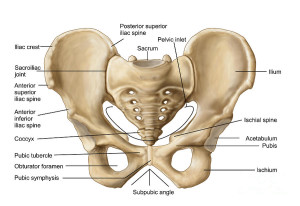Torqued Pelvis Symptoms
A torqued pelvis can cause not only lower back, hip and leg pain, but also upper body pain as the body tries to accommodate and adjust to the pelvic
imbalance. Common complaints include, "I feel like my lower body is facing a different direction than my upper body." or ""When I look in the mirror, my
body looks crooked."
Am I Susceptible?
A torqued pelvis is common and occurs in people of all ages and all occupations. No one is exempt. Is your pelvis torqued?
Visual Signs of Pelvis Torque
One of the first things I look at when working on a client is their pelvic balance. The pelvis is formed by five bones. The two largest are the ilium bones
(what most people think of as their hip bones). The ilium bones are joined in the back by our sacrum, which is rather triangular in shape. The Pelvic-
Anatomyother two bones in the pelvis are the ishium bones, the bones we sit on.
With the client in a prone position (face down), I check to see if the pelvis is level or torqued. A torqued pelvis has one ilium bone anteriorly rotated
and the other ilium bone posteriorly rotated. You can get an idea of what this looks like by closing your hands into fists and holding them side by side in
front of you. Rotate one fist forward and the other fist backward. This is what a torqued pelvis looks like.

Pelvic Anatomony
Our ligaments are the structures responsible for holding our bones together in correct alignment. When ligaments fail to do their job, either from damage,
such as sprains, or because the are overpowered by our muscles, bones move into incorrect alignment.
Leg Seems Shorter
A torqued pelvis is accompanied by a short leg on the side where the ilium bone is posteriorly rotated. When the ilium rotates backward, the attached leg is
pulled in a cephalid direction (towards the head), resulting in a shorter leg on that side. This does not mean the leg bone is actually shorter than the other
leg (known as an anatomically shorter leg), only that the leg measures shorter because its' point of attachment to the pelvis has moved.
Re-balancing the Pelvis to Eliminate Pain
In order to level, or rebalance the pelvis, I use a two-pronged approach. First, I shim the pelvis with pelvic blocks. These are wedge shaped blocks that and
placed under the pelvis at the appropriate place. With the blocks in place, gravity will cause the ilium bones to rotate back to the correct position.
Secondly, using muscle control techniques, I address the hypertonic (short and tight) muscles holding the pelvis out of balance. This relieves the muscles
pull on the pelvic bones, allowing the ilium bones to stay in the proper place.
What Should I Do?
If you have any of the symptoms mentioned or think you might have a torqued pelvis, call 603-537-9767 and ask for a free consultation.